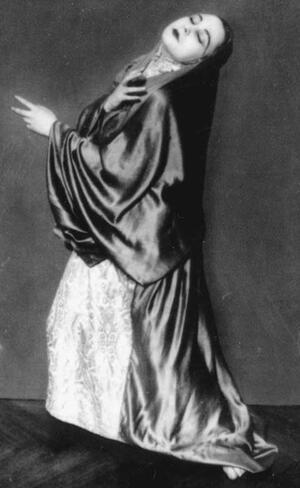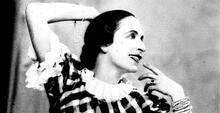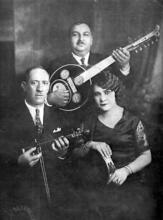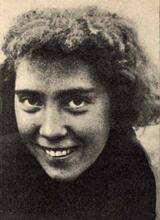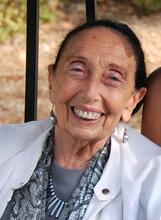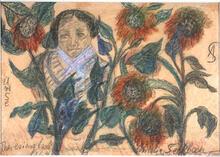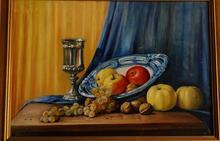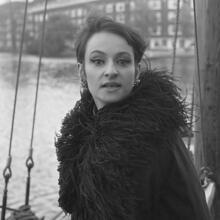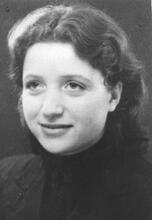Tatjana Barbakoff
Born Cilly Edelberg in Latvia in 1899, the dancer who called herself Tatjana Barbakoff (1899-1944) lacked formal dance training, yet created a world of her own through her charming personality, exotic stage costumes and lyrical dance expression. She is shown here in 1931.
Institution: Patrizia Veroli.
The daughter of a Chinese mother and a Russian Jewish father, Tatjana Barbakoff used her mixed heritage as inspiration for stunning and innovative dance performances. Barbakoff began learning ballet and performing Chinese dances at age ten. At nineteen she joined the Berlin literary cabaret Schall und Rauch, performing a mix of Russian and Chinese-inspired dances. Her expressive technique entranced critics, while her costumes inspired dozens of painters and sculptors to capture her likeness. In 1927 she formalized her ballet training under the ballerina Catherine Devilliers and expanded her repertoire. She fled Germany for Paris in 1933 and continued performing but was imprisoned after the German invasion in 1940. Freed during the armistice, she fled to Nice but was captured again in 1944 and sent to Auschwitz.
Early Life and Career
The art and sad fate of Tatjana Barbakoff have been saved from oblivion by the stubborn research of a German freelance writer, Günter Goebbels. She was born Cilly Edelberg in Libau (Liepaja) Latvia, at the time a province of the Tsarist Empire, on August 15, 1899. Her mother stemmed from China, while her father was a Russian Jew. The couple had two daughters, Cilly and Fani. As a child, Cilly played with the costly silks and brocades her mother had brought from China and thus began to dance. She attended a ballet school and appeared in Chinese dances at the age of ten. Her mother’s death and her father’s remarriage to a Russian-Jewish woman named Sora (Sarah) led the nineteen-year-old to leave for Germany in the wake of Georg Waldmann (1880–1945?), a German soldier who had served in Latvia during World War I. The couple married and moved to Berlin, where Waldmann worked as a singer under the name of Marcel Boissier. There she danced in the famous literary cabaret Schall und Rauch (Noise and Smoke), run by the Jewish director Max Reinhardt (1873–1943).
The earliest document relating to her solo performance dates from March 28, 1921. Under the name of Tatjana Barbakoff she danced Tatjana: A Vision of Ash Wednesday in Seven Metamorphoses, a series of seven solos (Prologue, Russian Passion, Caucasian Fairytale Princess, Expression, Serenade, Religious Struggle, Circus Child), accompanied by Waldmann. Though lacking formal dance training, she seems to have had a mostly lyrical talent, inclined rather to harmonious posing than to impulsive movement. She was able to shape a world of her own, colored by Russian memories and exotic dreams, in a country and at a time when the so-called Ausdruckstanz (Expressive Dance) was imbued with identity struggles and political claims. “It’s not only dance,” wrote French critic Fernand Divoire (1883–1950) in 1935, “it’s not only mime, it’s almost an animated drawing.” Her miming could be extremely delicate, though her simple gestures could also convey an assertive inner strength. “Her curious, small moon-shaped face,” wrote Divoire, “could either become void of expression or communicate dramatic feelings in the most extraordinary way.”
Barbakoff debuted as a soloist in Berlin in 1925 and toured throughout Germany. Together with Waldmann she joined Corso, the literary Düsseldorf cabaret, and also the Cologne dance cabaret Simplizissimus. Her charming personality and especially her colorful, exotic Chinese and Russian stage costumes (made according to her own design) made her a favorite subject for painters and sculptors such as Otto Pankok (1893–1966), Waldemar Flaig (1892–1932), Eugen Spiro (1874–1972), Arthur Grunenberg (1880–1952), Christian Rohlfs (1849–1938), Benno Elkan (1877–1960), and the photographers Willy Maywald (1907–1985) and Hans Robertson (1880–1950). In Düsseldorf she was in contact with the art gallery run by Johanna Ey (“Mutter Ey,” 1864–1947) and the artistic movement “Das junge Rheinland.” In Berlin she joined the large Russian Jewish community and was often painted by Gert Heinrich Wollheim (1894–1974).
Rise to Fame
In 1927 Barbakoff, now in love with Wollheim, separated from Waldmann but did not divorce him. By this time she had begun ballet training with the Diaghilev ballerina Catherine Devilliers, and made friends with Julia Tardy Marcus (1905–2002), a Jewish modern dancer who was a pupil of Mary Wigman (1886–1973). From 1929 to 1935 she was invited by the German expressionist painter Christian Rohlfs and his wife Helene (née Voght, 1892–1990) to Ascona, Switzerland, and danced in the private theater San Materno, run by the Jewish dancer Charlotte Bara (C. Bachrach, 1901–1986). By 1932 Barbakoff’s repertoire included Church Images of Old Russia (to music by Gretschaninoff), Double Face (Bartok), Through Gardens (Bartok), Mongolian Flag Bearer, Reminiscence (Händel), Chatting Women (Hummel), Five o’clock (Brodski), By the Waters of Babylon they sat and wept (Ravel), Mathilde (from a series inspired by the French painter Marie Laurencin (1883–1956), to music by Mozart), and A Little Russian Popular Song. Clear evidence of the fame attained by Barbakoff can be seen in several of the highly popular photo-albums distributed by cigarette manufacturers, which in the early 1930s published a number of photographs of her.
World War II
In April 1933 Barbakoff fled from Germany, using the program of a Paris performance scheduled for May 9 to enable her to take all her costumes with her. Wollheim too moved to Paris, where the couple lived together. Here she performed at the Dance Academy founded by Isadora Duncan’s brother, Raymond (1874–1966), and was warmly welcomed by critics. Divoire greatly appreciated dances such as Religious Images, in which she wore a wide red cape. “When she raises her hands together over her head,” he wrote, “the whole of her body seems an arrow pointing her prayer toward the sky.”
When the Germans invaded France in May 1940, Tatjana was interned at the Gurs detention camp. After the armistice between France and Germany, she was freed and managed to reach Nay (near Lourdes), where she was finally joined by Wollheim in September 1942. Here they were able to hide in the home of a peasant. Disregarding Wollheim’s advice, Tatjana fled once again, this time to Nice, since the French Côte d’Azur, controlled by the Italian police, was known to be a refuge for Jews. On September 8, 1943 Italy made peace with the western allies and the Germans occupied the Italian zone of France which included Nice. In January 1944 Tatjana was arrested and interned in the assembly and detention camp at Drancy, a suburb of Paris. From there she was dispatched to Auschwitz, where she was gassed on February 6, 1944. Her sister, who had visited Tatjana both in Berlin (c. 1928) and in Paris (c. 1935), was deported to Poland, together with her illegitimate son in June 1943 and never returned. Her stepmother was killed in the murderous action on the shore of the Baltic Sea on December 15, 1941.
Legacy
In 1986 Julia Tardy-Marcus established a Tatjana Barbakoff Dance Award in Paris. A number of Barbakoff’s stage costumes were donated to the Düsseldorf City Museum by Gert Wollheim’s widow, Mona Loeb (1908–1997). An oil on wood portrait of Barbakoff, which Wollheim painted in 1928, is in the possession of the Israel Museum in Jerusalem. On the memorial wall of the Museum of the Shoah in Paris, she appears under the name of Cilly Waldmann.
In November 2005 an extensive exhibition of art works inspired by and portraying Barbakoff, curated by Günter Goebbels, was held in Dortmund, where she had performed twice in 1932. The public interest the exhibition aroused led to its being extended until mid-summer, 2006.
Fernand Divoire, Pour la danse, Editions de la danse, Paris 1935;
Günter Goebbels, “Tatjana Barbakoff,” in Tatjana Barbakoff 1899 Libau-1944 Auschwitz, Stadtmuseum Düsseldorf, exhibition catalogue, 1991;
Mary Wigman-Gesellschaft e.V., “Tatjana Barbakoff,” in Tanzdrama, n. 25, 1994;
Hildegard Reinhardt in Collaboration with Günter Goebbels, Tatjana Barbakoff, Tänzerin und Muse, August Macke House, Bonn, Exhibition Catalogue, 2002.

